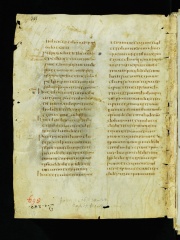Codex Sangallensis 1395
From Textus Receptus
The Codex Sangallensis 1395, designated by Σ, is a 5th century Latin manuscript of the New Testament. The text, written on vellum, is a version of the Latin Vulgate.[1]
Contents |
Description
The manuscript contains the text of the four Gospels (Matthew 6:21–Johannes 17:18), with numerous lacunae. The Latin text of the Gospels is a representative of the Latin Vulgate.[1] It contains 320 parchment leaves (23 by 18.5 cm). The leaves are arranged in quarto.[2]
The order of Gospels is an usual.[2]
The nomina sacra are written in an abbreviated way.[3] The words at the end of line are abbreviated. It uses also a few another abbreviations.[4] The Hebrew names like Ααρων, Ισαακ, Αβρααμ, Βεθλεεμ were Latinized by dropping one of the repeated vowels, or by insertion of letter "h" between them. Although forms like Aron and Aharon, Isac and Isahac, Bethlem and Bethlehem occur in the manuscript, the Old-Latin standard forms were Aron and Isac.[5]
It has some singular readings in the Gospel of Matthew (11:4; 14:2; 16:9.10; 17:26; 18:9; 26:45.47; 27:59; 28:1) and in Mark (4:7; 4:11; 6:33; 14:21).[6]
History
The manuscript was written in Verona in the 5th century. E. A. Lowe even thought it possible that the manuscript could have been written during the lifetime of Jerome.[1] It is also dated to the 6th century.[2] Probably it is the oldest manuscript of the Latin Vulgate.[1]
In the Middle Ages it was used for rebinding other manuscripts and about half of the codex has survived.[1]
The text was published by C. H. Turner,[7] A. Dold.[1]
Currently it is housed at the Abbey library of Saint Gall (1395) in St. Gallen.[1]
See also
References
- 1. Metzger, Bruce M. (1977). The Early Versions of the New Testament. London: Oxford University Press. p. 335. ISBN 0-19-826170-5.
- 2. Cod. Sang. 1395 at the e-codices
- 3. C. H. Turner, The oldest manuscript of the Vulgate Gospels (Oxford 1931), pp. XXVI–XXVIII.
- 4. C. H. Turner, The oldest manuscript of the Vulgate Gospels (Oxford 1931), pp. XXVIII–XXX.
v5. C. H. Turner, The oldest manuscript of the Vulgate Gospels (Oxford 1931), p. XXXVIII.
- 6. C. H. Turner, The oldest manuscript of the Vulgate Gospels (Oxford 1931), pp. XXXI–XXXIV.
- 7. C. H. Turner, The oldest manuscript of the Vulgate Gospels (Oxford 1931)
Further reading
- C. H. Turner, The oldest manuscript of the Vulgate Gospels (Oxford 1931)
External links
- Cod. Sang. 1395 at the e-codices

